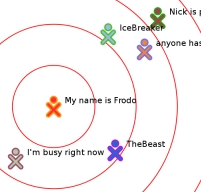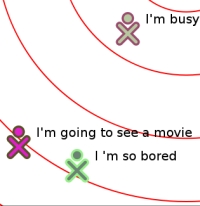We have all seen the original Sugar mesh network display showing other users of XO laptops. Clustering of little XO icons indicate others collaborating on different activities or single users randomly placed on the screen. Now, according to Walter Bender, we have 'Space', an intelligent display of users in your XO neighborhood with your XO in the center:
Mesh view: Polychronis Ypodimatopoulos has developed a new activity, "Space," which displays an alternative mesh network neighborhood; it offers a sense of space by placing you in the center and everyone else in the mesh network at a distance proportional to link quality between you and the node that is being displayedAs I had proposed in a comment on OLPCNews some time back, use is being made of the mesh network in some interesting ways.
While this new way to display XO users in Sugar is not what I would call 'Location Finding', its certainly a step in the right direction. 'Space' is making use of the networking protocol behind the mesh network and applying this to a map showing how many hops away other users are. As a result you get a real feeling of distance displayed on the screen rather than having information on who is collaborating.
For some time now, WiFi technology infrastructure has been used by several big players to provide facilities for 'Asset Tracking' of equipment or people. Just recently the Carolinas Healthcare System in the USA selected Ekahau Inc. to provide Wifi based real time location systems. University Campuses are looking at locating students, Hospitals want to locate medical equipment and manufacturers want to locate tools or even production items.
The technology for locating Wifi devices is based on several methods. The most common and least accurate is based on signal strength or RSSI. Some systems can utilise a 'Time Of Arrival' system similar to the way GPS works. So why wouldn't a signal strength system work with the XO?
Well it would but of course you need at least two other XO's providing your XO with strength of the Wifi signal. You can then map a triangle with three sides of known distance/length. With three known sides you can calculate the three angles in the triangle and plot the two important values, Distance and angle (compared to the other XOs). By adding in several fixed location wifi access points you obtain a real world fixed point orientation.
In a situation where the school has a Server and several Access Points the school staff can quite easily track locations of all the laptops in a school. Considering that the safety of the children is of utmost importance and knowing where the laptops are located (with the child attached) we begin to see the advantage of locating systems as an integral part of the laptops.
Could we see the development of software based on XO mesh signal strength? I'd like to think kids will be playing 'Hide And Seek' with their laptops using the wireless network to find others. If we take the idea a step further and make it really useful, we may see teachers receiving an email from the school server when a students laptop ventures outside of the school grounds during school hours.
The technology is available. It just waits for an enterprising person to produce the software.




People knock Negroponte's constructivist educational philosophy, but this is an example of how it pays off. One of the basic principles of constructivism, as opposed to standard educational theory, is that children learn through collaboration.
So when olpc set to work, they designed the hardware and software from the bottem up for collaboration, unlike other platforms. It was this that lead to the original mesh network display, plus the space modification. Classmate, on the other hand, is based around the standard educational model, so it doesn't have anything like this.
What about security issues? In an open platform that doesn't uses password, it means that once you have access to one O laptop you can geolocate every kid on the proximities.
That's probably more dangerous than safe. Yes your school and your parents can find you but so do pedophiles, or simple older bullies. And unfortunately, they will probably be paying more attention..
Take a look at Bitfrost:
http://wiki.laptop.org/go/Bitfrost
"That's probably more dangerous than safe. Yes your school and your parents can find you but so do pedophiles, or simple older bullies. And unfortunately, they will probably be paying more attention.."
Obviously, we would like to have the location function under the control of the located child. This would also be in the spirit of the OLPC security model. However, as the localization is done by others, this could be difficult to enforce. It depends on how the packets are routed.
It is not clear to me what threat model includes pedophiles using this laptop function. Globally seen, pedophiles are not in the top 10 threats to children's physical safety in the developing world.
Winter